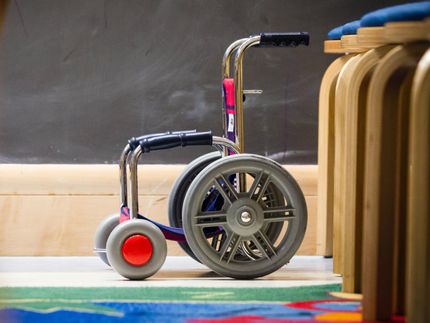Three parents and a baby
Scientists advise caution with regard to artificial insemination method
Advertisement
mitochondria are cell organelles located within animal and human cells. They produce energy for the organism, possess their own genetic material - mitochondrial DNA (mtDNA) - and are transmitted exclusively by the mother. Depending on their activity and tasks, different numbers of mitochondria are present in a cell - usually a few hundred to a thousand per body cell.

Already a few dysfunctional mitochondria (in yellow on top of the picture) could cause a disease by overgrowing functional ones (in blue).
Iain Johnston
Inherited mitochondrial disorders or so-called mitochondropathies occur in about one of 10,000 humans throughout the world. Diseases such as diabetes, stroke, cardiac defects, epilepsy, or muscle weakness may originate from mitochondrial defects. Inherited mitochondrial disorders have been incurable so far. Therefore, efforts are now being made to enable women with this disease to bear healthy children by means of nuclear transfer.
Mitochondria multiply at different rates
Jörg Burgstaller, a scientist and member of Gottfried Brem's research group at the Vetmeduni Vienna, has been working for several years on the genetics of mitochondria. It was known before that different types of mitochondria within a cell can proliferate at different rates. However, it was not known whether this is a singular phenomenon or if these cases occur more frequently.
Burgstaller investigated this in four newly bred mouse models which carried different mixtures of mitochondria whose DNA were related to each other to a differing extent. This meant no health problem for the mice since all mtDNAs are were fully functional.
The outcome was: the more distantly two types of mitochondria within an egg cell were related, the more frequently a growth advantage was noted in favor of one of the two types of mitochondria. When two different mtDNAs were equally common in cells of an organ at the time of birth, one type was completely lost after a while. One mitochondria variant had thus achieved a growth advantage compared to the other variant and superseded the latter. This effect was almost non-existent in genetically very similar mitochondria within the cells; the ratio between the two types of mitochondria was not altered in that case.
The effect is of significance in reproduction medicine
Burgstaller's results may have effects on the planned introduction of the so called "Three-Parent Baby" in Great Britain. Experts take the cell nucleus of one human egg cell whose mitochondria have a defect and place it in an egg cell with "healthy" mitochondria. The baby resulting from this procedure has three parents, namely the mother whose cell nucleus is used, the mother whose mitochondria are involved, and the father whose sperm inseminated the egg cell.
However, this method raises the following problem: in every nuclear transfer, a small number of defective mitochondria are transferred into the healthy egg cell. "So far it was believed that this minimal 'contamination' is of no consequence for the baby. However, our data show that the effect may have dramatic consequences on the health of the offspring. If the mitochondria of both mothers are genetically very different, it may have the same effects seen in the mouse model," says Burgstaller who developed the theory together with co-author Joanna Poulton, Professor of Mitochondrial Genetics at the John Radcliffe Hospital in Oxford. "One mitochondrial type may be able to assert itself against the other. If the assertive one happens to carry the defective mtDNA, the benefit of the therapy would be jeopardized."
The solution to the "Three-Parent Baby"-problem
Burgstaller and his colleagues suggest the following solution to the problem: the mtDNA of both mothers, i.e. the donor of the nucleus and the donor of the mitochondria, should be analyzed in advance and aligned to each other. So called "machting haplotypes" could prevent the dangerous effect. In the future the effect may even be utilized in a targeted manner to suppress defective mtDNA.




























































